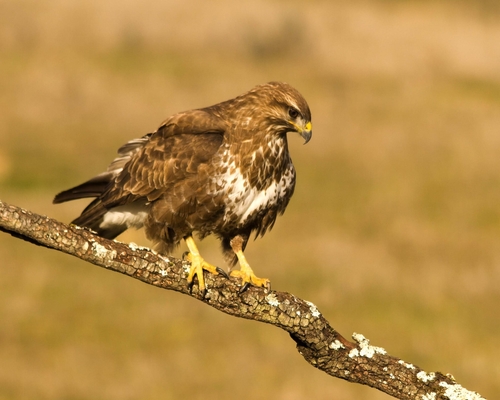
Common Buzzard
The Common Buzzard (*Buteo buteo*) is a medium-sized raptor widely distributed across Europe and Asia. Known for its adaptability, it occupies a variety of habitats, playing a crucial role in controlling rodent populations. It is a familiar sight, often seen soaring on broad wings or perched on vantage points. While not globally threatened, localized populations face challenges from habitat loss and persecution. The Common Buzzard holds no particular cultural significance other than being a symbol of wilderness and freedom in some regions, representing the balance of nature.
40-58 cm
Length
109-136 cm
Wingspan
Least Concern
Conservation Status
Distribution
Widespread across Europe and Asia, extending from the British Isles and Iberia eastward to Japan. Migratory populations breed in northern regions and winter further south, reaching parts of Africa and the Middle East. Altitudinal range varies from sea level to mountainous areas up to 2,000 meters.
Lifespan
Up to 25 years in the wild, though average lifespan is likely shorter. Captive birds can live longer.
Common Buzzard's Habitat
Habitat Types
Woodlands, Farmlands, Moorlands, Grasslands, Coastal areas
Climate Zones
Temperate, Boreal, Mediterranean
Adaptations
Highly adaptable to various habitats due to its broad diet and flexible nesting preferences. Can thrive in both open and wooded landscapes, provided there are suitable nesting sites and sufficient prey availability.
Variations
Multiple subspecies are recognized, exhibiting variations in plumage and size. For example, *Buteo buteo vulpinus* (Steppe Buzzard) is smaller and paler, found in eastern Europe and Asia.
Appearance
Breeding Plumage
Plumage is generally similar year-round, though fresh plumage after molting may appear brighter.
Seasonal Feather Changes
Minor seasonal variations; molting occurs primarily in late summer and autumn.
Sex Based Plumage Differences
Minimal sexual dimorphism in plumage; females may have slightly broader barring on the tail and underparts.
Notable Features
Broad, rounded wings, Short, rounded tail, Variable plumage, ranging from dark brown to almost white, Dark 'wrist' marks on the underside of the wings
Diet and Feeding
Primary Foods
Small mammals (voles, mice, rabbits), Birds, Reptiles, Amphibians, Invertebrates (earthworms, beetles)
Foraging Behavior
Primarily hunts from perches, using keen eyesight to spot prey. Also soars and glides, searching for movement on the ground. Occasionally hovers, particularly in windy conditions.
Specializations
No highly specialized feeding adaptations; a generalist predator with a broad diet.
Seasonal Diet Variations
Diet varies seasonally depending on prey availability. In winter, may rely more on carrion and earthworms when small mammals are less active.
Behavior
Social Structure
Generally solitary or found in pairs, except during migration or at abundant food sources where loose aggregations may form.
Communication
Mewing calls, often described as a 'kee-yaa', Visual displays during courtship and territorial defense
Migration
Northern populations are migratory, while southern populations are largely resident. Migratory routes vary depending on breeding location.
Territorial or Group Behaviors
Defends breeding territories against other buzzards. Territories can vary in size depending on habitat and prey density.
Conservation
Threats
Habitat loss (deforestation, agricultural intensification), Illegal persecution (shooting, poisoning), Collision with vehicles and power lines, Secondary poisoning from rodenticides
Protection Programs
Protected under various national and international wildlife laws, Habitat restoration and management initiatives, Public awareness campaigns to reduce persecution
Local National Laws
Protected under the Wildlife and Countryside Act 1981 in the UK, and similar legislation across its range.
Population Trend
Stable
Population Estimates
Global population estimated to be 3.1-4.4 million mature individuals.
Interesting Facts
Common Buzzards exhibit a wide range of plumage variations.
This makes identification challenging, as individuals can range from very dark brown to almost completely white.
They are opportunistic hunters.
Their diet is highly adaptable, allowing them to thrive in diverse environments.
They often reuse nests year after year.
Some nests can become very large over time, with layers of sticks and other materials added each breeding season.
They can be confused with other raptors, such as the Rough-legged Buzzard.
Careful observation of plumage and flight patterns is needed for accurate identification.
Faqs about Common Buzzard
What is the call of a Common Buzzard?
The Common Buzzard has a distinctive mewing call, often described as a plaintive 'kee-yaa'.
Are Common Buzzards endangered?
No, the Common Buzzard is classified as 'Least Concern' by the IUCN, meaning it is not currently considered to be at risk of extinction.
What do Common Buzzards eat?
Common Buzzards have a varied diet, primarily consisting of small mammals like voles and mice, but also including birds, reptiles, amphibians, and invertebrates.
Where do Common Buzzards nest?
They typically build large stick nests in trees, on cliffs, or sometimes on the ground.
Copyright @ Nature Style Limited. All Rights Reserved.
 English
English